Exploring the Importance of Environmental Complexity for Newly Hatched Zebrafish
Abstract
:Simple Summary
Abstract
1. Introduction
2. Materials and Methods
2.1. Animal Housing
- Experiment 1: Continuous quantity discrimination
- Experiment 2: number discrimination
- Experiment 3: Preference for enriched environment
2.2. Statistical Analyses
3. Results
- Experiment 1: size discrimination
- Experiment 2: number discrimination
- Experiment 3: Preference for enriched environment
4. Discussion
4.1. Environmental Complexity and Cognition
4.2. Environmental Complexity and Behaviour
4.3. Preference for Environmental Complexity
4.4. Implications for Welfare
5. Conclusions
Supplementary Materials
Author Contributions
Funding
Institutional Review Board Statement
Informed Consent Statement
Data Availability Statement
Acknowledgments
Conflicts of Interest
References
- Blakemore, C.; Cooper, G.F. Development of the brain depends on the visual environment. Nature 1970, 228, 477–478. [Google Scholar] [CrossRef] [PubMed]
- Krech, D.; Rosenzweig, M.R.; Bennett, E.L. Relations between brain chemistry and problem-solving among rats raised in enriched and impoverished environments. J. Comp. Physiol. Psych. 1962, 55, 801. [Google Scholar] [CrossRef] [PubMed]
- Seay, B.; Alexander, B.K.; Harlow, H.F. Maternal behaviour of socially deprived Rhesus monkeys. J. Abnorm. Soc. Psych. 1964, 69, 345. [Google Scholar] [CrossRef] [PubMed]
- Burghardt, G.M. Environmental enrichment and cognitive complexity in reptiles and amphibians: Concepts, review, and implications for captive populations. Appl. Anim. Behav. Sci. 2013, 147, 286–298. [Google Scholar] [CrossRef]
- Campbell, D.L.M.; De Haas, E.N.; Lee, C. A review of environmental enrichment for laying hens during rearing in relation to their behaviour al and physiological development. Poultry Sci. 2019, 98, 9–28. [Google Scholar] [CrossRef] [PubMed]
- Näslund, J.; Johnsson, J.I. Environmental enrichment for fish in captive environments: Effects of physical structures and substrates. Fish. Fish. 2016, 17, 1–30. [Google Scholar] [CrossRef]
- Salvanes, A.G.V.; Moberg, O.; Ebbesson, L.O.; Nilsen, T.O.; Jensen, K.H.; Braithwaite, V.A. Environmental enrichment promotes neural plasticity and cognitive ability in fish. P. Roy. Soc. B-Biol. Sci. 2013, 280, 20131331. [Google Scholar] [CrossRef] [PubMed]
- Berejikian, B.A.; Tezak, E.P.; Riley, S.C.; LaRae, A.L. Competitive ability and social behaviour of juvenile steelhead reared in enriched and conventional hatchery tanks and a stream environment. J. Fish. Biol. 2001, 59, 1600–1613. [Google Scholar] [CrossRef]
- Salvanes, A.G.V.; Braithwaite, V.A. Exposure to variable spatial information in the early rearing environment generates asymmetries in social interactions in cod (Gadus morhua). Behav. Ecol. Sociobiol. 2005, 59, 250–257. [Google Scholar] [CrossRef]
- Strand, D.A.; Utne-Palm, A.C.; Jakobsen, P.J.; Braithwaite, V.A.; Jensen, K.H.; Salvanes, A.G. Enrichment promotes learning in fish. Mar. Ecol. Prog. Ser. 2010, 412, 273–282. [Google Scholar] [CrossRef]
- Bergendahl, I.A.; Salvanes, A.G.V.; Braithwaite, V.A. Determining the effects of duration and recency of exposure to environmental enrichment. Appl. Anim. Behav. Sci. 2016, 176, 163–169. [Google Scholar] [CrossRef]
- Claxton, A.M. The potential of the human–animal relationship as an environmental enrichment for the welfare of zoo-housed animals. Appl. Anim. Behav. Sci. 2011, 133, 1–10. [Google Scholar] [CrossRef]
- Godyń, D.; Nowicki, J.; Herbut, P. Effects of environmental enrichment on pig welfare—A review. Animals 2019, 9, 383. [Google Scholar] [CrossRef] [PubMed]
- Morris, C.L.; Grandin, T.; Irlbeck, N.A. Companion animals symposium: Environmental enrichment for companion, exotic, and laboratory animals. J. Anim. Sci. 2011, 89, 4227–4238. [Google Scholar] [CrossRef] [PubMed]
- Whitham, J.C.; Wielebnowski, N. New directions for zoo animal welfare science. Appl. Anim. Behav. Sci. 2013, 147, 247–260. [Google Scholar] [CrossRef]
- Coulon, M.; Henry, L.; Perret, A.; Cousillas, H.; Hausberger, M.; George, I. Assessing video presentations as environmental enrichment for laboratory birds. PLoS ONE 2014, 9, e96949. [Google Scholar] [CrossRef] [PubMed]
- Poggiagliolmi, S.; Crowell-Davis, S.L.; Alworth, L.C.; Harvey, S.B. Environmental enrichment of New Zealand White rabbits living in laboratory cages. J. Vet. Behav. 2011, 6, 343–350. [Google Scholar] [CrossRef]
- Toth, L.A.; Kregel, K.; Leon, L.; Musch, T.I. Environmental enrichment of laboratory rodents: The answer depends on the question. Comparative Med. 2011, 61, 314–321. [Google Scholar]
- Williams, T.D.; Readman, G.D.; Owen, S.F. Key issues concerning environmental enrichment for laboratory-held fish species. Lab. Anim. 2009, 43, 107–120. [Google Scholar] [CrossRef]
- Bayne, K.; Würbel, H. The impact of environmental enrichment on the outcome variability and scientific validity of laboratory animal studies. Rev. Sci. Tech. OIE 2014, 33, 273–280. [Google Scholar] [CrossRef]
- Minie, V.; Ramos-Maciel, S.; Wright, E.; Petric, R.; Trainor, B.; Duque-Wilckens, N. Environmental enrichment delays the development of stereotypic behaviour and reduces variability in behaviour al experiments using California mice (Peromyscus californicus). BioRxiv 2021. [Google Scholar] [CrossRef]
- Pritchett-Corning, K.R. Environmental complexity and research outcomes. ILAR J. 2019, 60, 239–251. [Google Scholar] [CrossRef] [PubMed]
- Jones, N.A.; Webster, M.M.; Salvanes, A.G.V. Physical enrichment research for captive fish: Time to focus on the DETAILS. J. Fish. Biol. 2021, 99, 704–725. [Google Scholar] [CrossRef] [PubMed]
- Stevens, C.H.; Reed, B.T.; Hawkins, P. Enrichment for laboratory zebrafish—A review of the evidence and the challenges. Animals 2021, 11, 698. [Google Scholar] [CrossRef] [PubMed]
- Aleström, P.; D’Angelo, L.; Midtlyng, P.J.; Schorderet, D.F.; Schulte-Merker, S.; Sohm, F.; Warner, S. Zebrafish: Housing and husbandry recommendations. Lab. Anim. 2020, 54, 213–224. [Google Scholar] [CrossRef]
- Avitan, L.; Pujic, Z.; Mölter, J.; Van De Poll, M.; Sun, B.; Teng, H.; Amor, R.; Scott, E.K.; Goodhill, G.J. Spontaneous activity in the zebrafish tectum reorganizes over development and is influenced by visual experience. Curr. Biol. 2017, 27, 2407–2419. [Google Scholar] [CrossRef] [PubMed]
- Avdesh, A.; Chen, M.; Martin-Iverson, M.T.; Mondal, A.; Ong, D.; Rainey-Smith, S.; Taddei, K.; Lardelli, M.; Growth, D.M.; Verdile, G.; et al. Regular care and maintenance of a zebrafish (Danio rerio) laboratory: An introduction. J. Vis. Exp. 2012, 69, e4196. [Google Scholar]
- Norton, A.; Franse, K.F.; Daw, T.; Gordon, L.; Vitiello, P.F.; Kinkel, M.D. Larval rearing methods for small-scale production of healthy zebrafish. Eastern Biologist 2019, 2019, 33–46. [Google Scholar] [PubMed]
- Gatto, E.; Bruzzone, M.; Dal Maschio, M.; Dadda, M. Effects of environmental enrichment on recognition memory in zebrafish larvae. Appl. Anim. Behav. Sci. 2022, 247, 105552. [Google Scholar] [CrossRef]
- Gatto, E.; Dadda, M.; Bruzzone, M.; Chiarello, E.; De Russi, G.; Dal Maschio, M.; Bisazza, A.; Lucon-Xiccato, T. Environmental enrichment decreases anxiety-like behaviour in zebrafish larvae. Dev. Psychobiol. 2022, 64, e22255. [Google Scholar] [CrossRef]
- Aizenberg, M.; Schuman, E.M. Cerebellar-dependent learning in larval zebrafish. J. Neurosci. 2011, 31, 8708–8712. [Google Scholar] [CrossRef]
- Santacà, M.; Dadda, M.; Dalla Valle, L.; Fontana, C.; Gjinaj, G.; Bisazza, A. Learning and visual discrimination in newly hatched zebrafish. iScience 2022, 25, 104283. [Google Scholar] [CrossRef] [PubMed]
- Santacà, M.; Agrillo, C.; Miletto Petrazzini, M.E.; Bisazza, A. The ontogeny of continuous quantity discrimination in zebrafish larvae (Danio rerio). Anim. Cogn. 2020, 23, 731–739. [Google Scholar] [CrossRef] [PubMed]
- Santacà, M.; Caja, T.; Miletto Petrazzini, M.E.; Agrillo, C.; Bisazza, A. Size discrimination in adult zebrafish (Danio rerio): Normative data and individual variation. Sci. Rep. 2020, 10, 1164. [Google Scholar] [CrossRef] [PubMed]
- Rimstad, L.A.; Holcombe, A.; Pope, A.; Hamilton, T.J.; Schalomon, M.P. Preferences for achromatic horizontal, vertical, and square patterns in zebrafish (Danio rerio). PeerJ 2017, 5, e3748. [Google Scholar] [CrossRef] [PubMed]
- Lucon-Xiccato, T.; Gatto, E.; Bisazza, A. Quantity discrimination by treefrogs. Anim. Behav. 2018, 139, 61–69. [Google Scholar] [CrossRef]
- Bisazza, A.; Gatto, E. Continuous versus discrete quantity discrimination in dune snail (Mollusca: Gastropoda) seeking thermal refuges. Sci. Rep. 2021, 11, 3757. [Google Scholar] [CrossRef] [PubMed]
- Lucon-Xiccato, T.; Gatto, E.; Fontana, C.M.; Bisazza, A. Quantity discrimination in newly hatched zebrafish suggests hardwired numerical abilities. Commun. Biol. 2023, 6, 247. [Google Scholar] [CrossRef] [PubMed]
- Westerfield, M. The Zebrafish Book. A Guide for the Laboratory Use of Zebrafish (Danio rerio), 5th ed.; University of Oregon Press: Eugene, OR, USA, 2007. [Google Scholar]
- Hedge, J.M.; Hunter, D.L.; Sanders, E.; Jarema, K.A.; Olin, J.K.; Britton, K.N.; Lowery, M.; Knapp, M.B.; Padilla, S.; Hill, B.N. Influence of methylene blue or dimethyl sulfoxide on larval zebrafish development and behavior. Zebrafish 2023, 20, 132–145. [Google Scholar] [CrossRef]
- Abozaid, A.; Tsang, B.; Gerlai, R. The effects of small but abrupt change in temperature on the behaviour of larval zebrafish. Physiol. Behav. 2020, 227, 113169. [Google Scholar] [CrossRef]
- Buske, C.; Gerlai, R. Shoaling develops with age in Zebrafish (Danio rerio). Prog. Neuro-Psychoph 2011, 35, 1409–1415. [Google Scholar] [CrossRef]
- Dreosti, E.; Lopes, G.; Kampff, A.R.; Wilson, S.W. Development of social behaviour in young zebrafish. Front. Neural Circuit 2015, 9, 39. [Google Scholar] [CrossRef] [PubMed]
- Stednitz, S.J.; Washbourne, P. Rapid progressive social development of zebrafish. Zebrafish 2020, 17, 11–17. [Google Scholar] [CrossRef]
- Simpson, J.; Kelly, J.P. The impact of environmental enrichment in laboratory rats—Behavioural and neurochemical aspects. Behav. Brain Res. 2011, 222, 246–264. [Google Scholar] [CrossRef] [PubMed]
- Hernandez, R.E.; Galitan, L.; Cameron, J.; Goodwin, N.; Ramakrishnan, L. Delay of initial feeding of zebrafish larvae until 8 days postfertilization has no impact on survival or growth through the juvenile stage. Zebrafish 2018, 15, 515–518. [Google Scholar] [CrossRef]
- Browning, H. Assessing measures of animal welfare. Biol. Philos. 2022, 37, 36. [Google Scholar] [CrossRef]
- Dawkins, M.S. Behaviour as a tool in the assessment of animal welfare. Zoology 2003, 106, 383–387. [Google Scholar] [CrossRef] [PubMed]
- Duncan, I.J. Poultry welfare: Science or subjectivity? Brit Poultry Sci. 2002, 43, 643–652. [Google Scholar] [CrossRef]
- Andersson, M.; Kettunen, P. Effects of holding density on the welfare of zebrafish: A systematic review. Zebrafish 2021, 18, 297–306. [Google Scholar] [CrossRef]
- Daniel, D.K.; Bhat, A. Alone but not always lonely: Social cues alleviate isolation induced behavioural stress in wild zebrafish. Appl. Anim. Behav. Sci. 2022, 251, 105623. [Google Scholar] [CrossRef]
- Krueger, L.D.; Thurston, S.E.; Kirk, J.; Elsaeidi, F.; Freeman, Z.T.; Goldman, D.; Lofgren, J.L.; Keller, J.M. Enrichment preferences of singly housed zebrafish (Danio rerio). J. Am. Assoc. Lab. Anim. 2020, 59, 148–155. [Google Scholar] [CrossRef] [PubMed]
- Ramsay, J.M.; Feist, G.W.; Varga, Z.M.; Westerfield, M.; Kent, M.L.; Schreck, C.B. Whole-body cortisol is an indicator of crowding stress in adult zebrafish, Danio rerio. Aquaculture 2006, 258, 565–574. [Google Scholar] [CrossRef]
- Padilla, S.G. Further studies on the delayed pecking of chicks. J. Comp. Psychol. 1935, 20, 413. [Google Scholar] [CrossRef]
- Protti-Sánchez, F.; Mayer, U.; Rowland, H.M. In paired preference tests, domestic chicks innately choose the colour green over red, and the shape of a frog over a sphere when both stimuli are green. Anim. Cogn. 2023, 26, 1973–1983. [Google Scholar] [CrossRef]
- Sewards, T.V.; Sewards, M.A. Innate visual object recognition in vertebrates: Some proposed pathways and mechanisms. Comp. Biochem. Phys. A 2002, 132, 861–891. [Google Scholar] [CrossRef] [PubMed]
- Slater, A.; Kirby, R. Innate and learned perceptual abilities in the newborn infant. Exp. Brain Res. 1998, 123, 90–94. [Google Scholar] [CrossRef]
- Bisazza, A.; Piffer, L.; Serena, G.; Agrillo, C. Ontogeny of numerical abilities in fish. PLoS ONE 2010, 5, e15516. [Google Scholar] [CrossRef] [PubMed]
- Piazza, M.; Pica, P.; Izard, V.; Spelke, E.S.; Dehaene, S. Education enhances the acuity of the nonverbal approximate number system. Psychol. Sci. 2013, 24, 1037–1043. [Google Scholar] [CrossRef] [PubMed]
- Arechavala-Lopez, P.; Caballero-Froilán, J.C.; Jiménez-García, M.; Capó, X.; Tejada, S.; Saraiva, J.L.; Sureda, A.; Moranta, D. Enriched environments enhance cognition, exploratory behaviour and brain physiological functions of Sparus aurata. Sci. Rep. 2020, 10, 11252. [Google Scholar] [CrossRef]
- Meyer, M.M.; Johnson, A.K.; Bobeck, E.A. A novel environmental enrichment device increased physical activity and walking distance in broilers. Poultry Sci. 2020, 99, 48–60. [Google Scholar] [CrossRef]
- Zellner, D.; Padnos, B.; Hunter, D.L.; MacPhail, R.C.; Padilla, S. Rearing conditions differentially affect the locomotor behavior of larval zebrafish, but not their response to valproate-induced developmental neurotoxicity. Neurotoxicol Teratol. 2011, 33, 674–679. [Google Scholar] [CrossRef] [PubMed]
- Dawkins, M.S. The science of animal suffering. Ethology 2008, 114, 937–945. [Google Scholar] [CrossRef]
- Fraser, D.; Nicol, C.J. Preference and motivation research. In Animal Welfare; CAB International: Wallingford, UK, 2018; pp. 213–231. [Google Scholar]
- Kirkden, R.D.; Pajor, E.A. Using preference, motivation and aversion tests to ask scientific questions about animals’ feelings. Appl. Anim. Behav. Sci. 2006, 100, 29–47. [Google Scholar] [CrossRef]
- Crane, A.L.; Ferrari, M.C. Patterns of predator neophobia: A meta-analytic review. P. Roy. Soc. B-Biol. Sci. 2017, 284, 20170583. [Google Scholar] [CrossRef] [PubMed]
- Crane, A.L.; Brown, G.E.; Chivers, D.P.; Ferrari, M.C. An ecological framework of neophobia: From cells to organisms to populations. Biol. Rev. 2020, 95, 218–231. [Google Scholar] [CrossRef]
- Colwill, R.M.; Creton, R. Locomotor behaviours in zebrafish (Danio rerio) larvae. Behav. Process 2011, 86, 222–229. [Google Scholar] [CrossRef] [PubMed]
- Bruzzone, M.; Gatto, E.; Lucon-Xiccato, T.; Dalla Valle, L.; Fontana, C.M.; Meneghetti, G.; Bisazza, A. Measuring recognition memory in zebrafish larvae: Issues and limitations. PeerJ 2020, 8, e8890. [Google Scholar] [CrossRef]
- Strähle, U.; Scholz, S.; Geisler, R.; Greiner, P.; Hollert, H.; Rastegar, S.; Schumacher, A.; Selderslaghs, I.; Weiss, C.; Witters, H.; et al. Zebrafish embryos as an alternative to animal experiments—A commentary on the definition of the onset of protected life stages in animal welfare regulations. Reprod. Toxicol. 2012, 33, 128–132. [Google Scholar] [CrossRef]
- Álvarez, Y.; Colligris, B.; Kennedy, B.N. Affordable and effective optokinetic response methods to assess visual acuity and contrast sensitivity in larval to juvenile zebrafish. Open Res. Europe 2021, 1, 92. [Google Scholar] [CrossRef]
- Lindsay, S.M.; Vogt, R.G. Behaviour al responses of newly hatched zebrafish (Danio rerio) to amino acid chemostimulants. Chem. Senses 2004, 29, 93–100. [Google Scholar] [CrossRef]
- Park, J.S.; Ryu, J.H.; Choi, T.I.; Bae, Y.K.; Lee, S.; Kang, H.J.; Kim, C.H. Innate color preference of zebrafish and its use in behaviour al analyses. Mol. Cells 2016, 39, 750. [Google Scholar] [CrossRef] [PubMed]
- Kistler, C.; Hegglin, D.; Würbel, H.; König, B. Preference for structured environment in zebrafish (Danio rerio) and checker barbs (Puntius oligolepis). Appl. Anim. Behav. Sci. 2011, 135, 318–327. [Google Scholar] [CrossRef]
- Tan, S.L.T.; Handasyde, K.A.; Rault, J.L.; Mendl, M. Insensitivity to reward shifts in zebrafish (Danio rerio) and implications for assessing affective states. Anim. Cogn. 2020, 23, 87–100. [Google Scholar] [CrossRef]
- Ennaceur, A.; Delacour, J. A new one-trial test for neurobiological studies of memory in rats. 1: Behavioral data. Behav. Brain Res. 1988, 31, 47–59. [Google Scholar] [CrossRef] [PubMed]
- May, Z.; Morrill, A.; Holcombe, A.; Johnston, T.; Gallup, J.; Fouad, K.; Schalomon, M.; Hamilton, T.J. Object recognition memory in zebrafish. Behav. Brain Res. 2016, 296, 199–210. [Google Scholar] [CrossRef] [PubMed]
- Terry, W.S. Habituation and dishabituation of rats’ exploration of a novel environment. Anim. Learn. Behav. 1979, 7, 525–536. [Google Scholar] [CrossRef]
- Spence, R.; Fatema, M.K.; Reichard, M.; Huq, K.A.; Wahab, M.A.; Ahmed, Z.F.; Smith, C. The distribution and habitat preferences of the zebrafish in Bangladesh. J. Fish. Biol. 2006, 69, 1435–1448. [Google Scholar] [CrossRef]
- Spence, R.; Ashton, R.; Smith, C. Oviposition decisions are mediated by spawning site quality in wild and domesticated zebrafish, Danio rerio. Behaviour 2007, 144, 953–966. [Google Scholar] [CrossRef]
- Parichy, D.M.; Postlethwait, J.H. The biotic and abiotic environment of zebrafish. In Behaviour al and Neural Genetics of Zebrafish; Academic Press: Cambridge, MA, USA, 2020; pp. 3–16. [Google Scholar]
- Suriyampola, P.S.; Shelton, D.S.; Shukla, R.; Roy, T.; Bhat, A.; Martins, E.P. Zebrafish social behaviour in the wild. Zebrafish 2016, 13, 1–8. [Google Scholar] [CrossRef]
- DePasquale, C.; Neuberger, T.; Hirrlinger, A.M.; Braithwaite, V.A. The influence of complex and threatening environments in early life on brain size and behaviour. P. Roy. Soc. B-Biol. Sci. 2016, 283, 20152564. [Google Scholar] [CrossRef]
- Ashlin, T.G.; Blunsom, N.J.; Ghosh, M.; Cockcroft, S.; Rihel, J. Pitpnc1a regulates zebrafish sleep and wake behavior through modulation of insulin-like growth factor signaling. Cell Rep. 2018, 24, 1389–1396. [Google Scholar] [CrossRef] [PubMed]
- Desvignes, T.; Robbins, A.E.; Carey, A.Z.; Bailon-Zambrano, R.; Nichols, J.T.; Postlethwait, J.H.; Stankunas, K. Coordinated patterning of zebrafish caudal fin symmetry by a central and two peripheral organizers. Dev. Dynam 2022, 251, 1306–1321. [Google Scholar] [CrossRef] [PubMed]
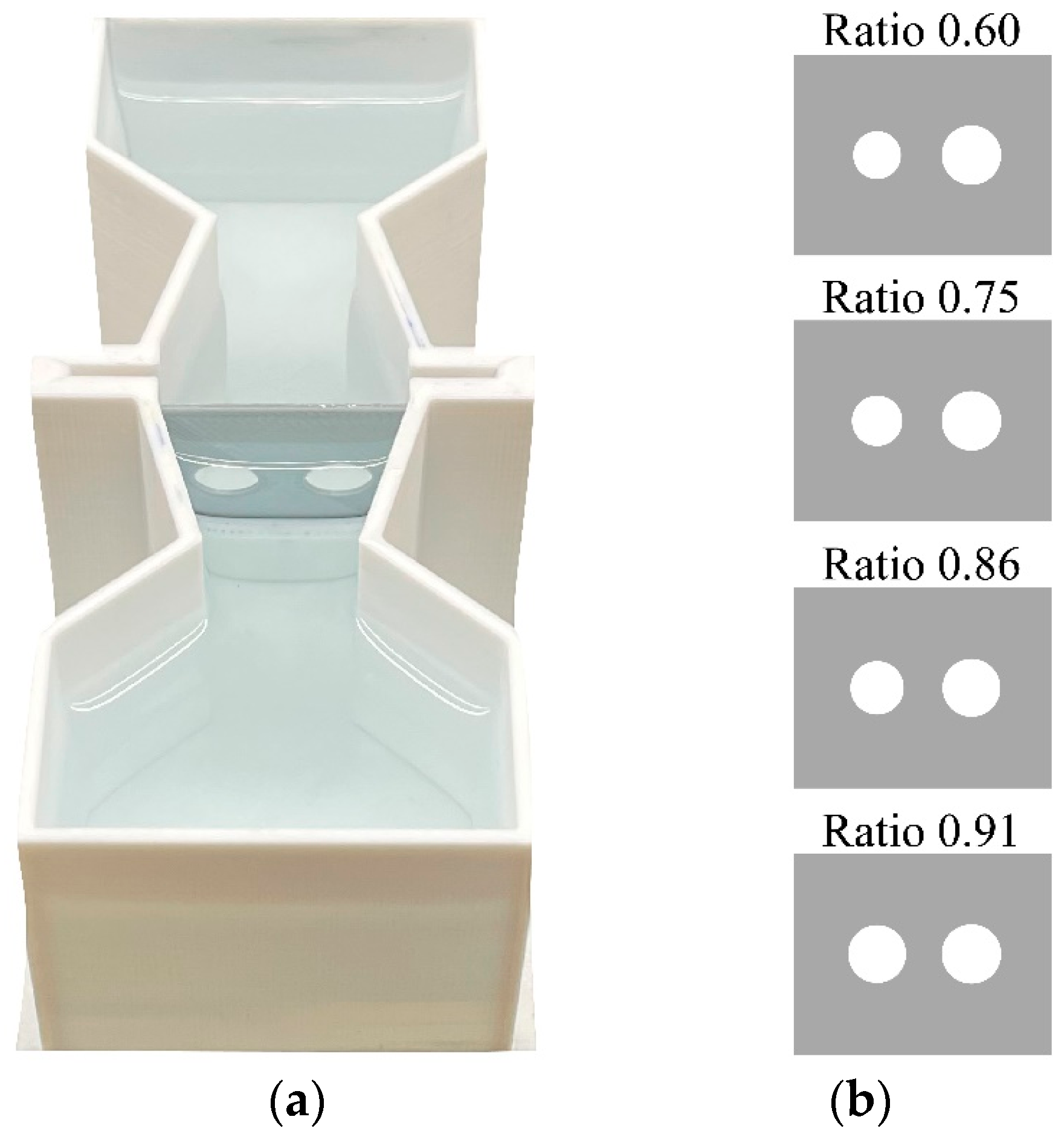

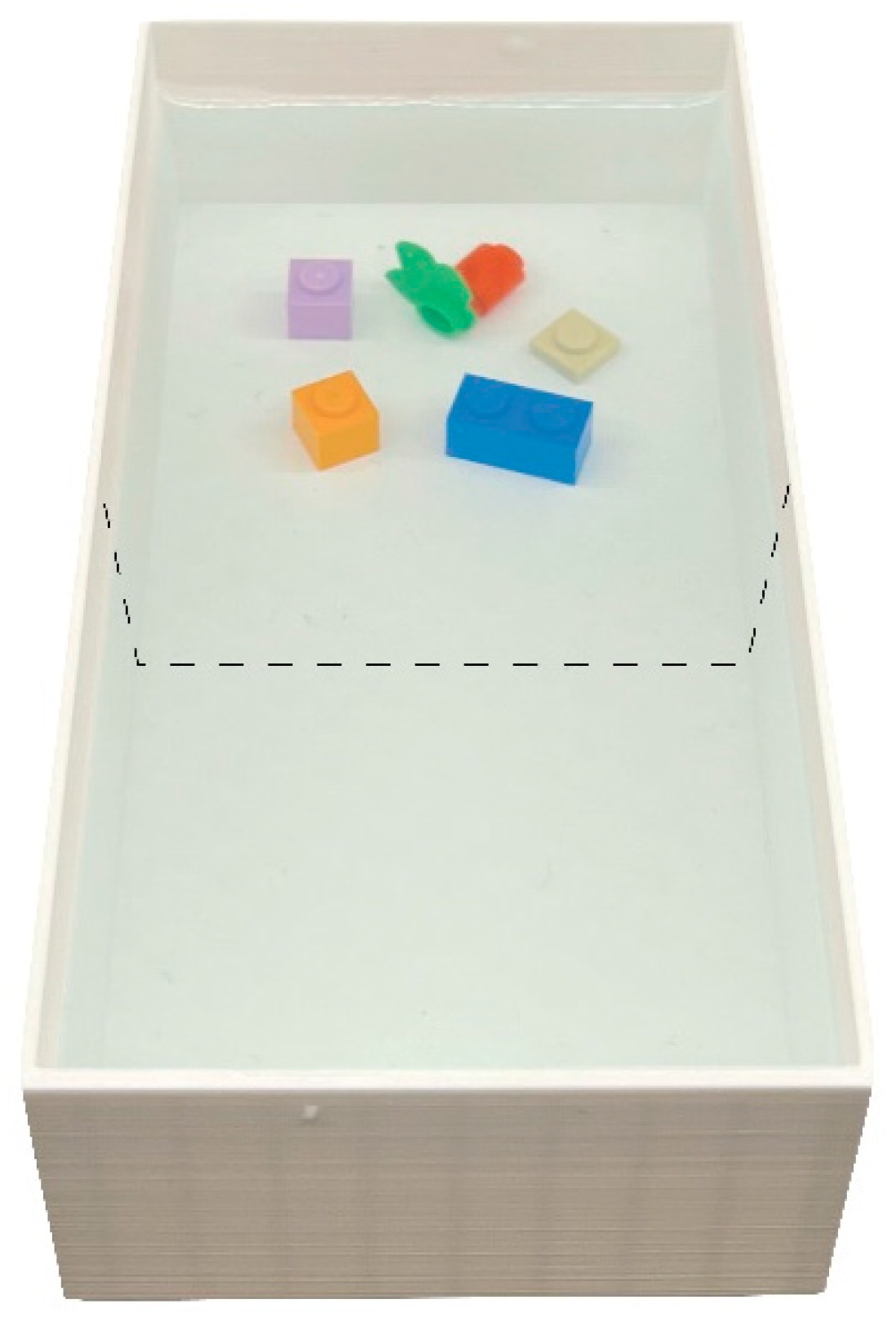
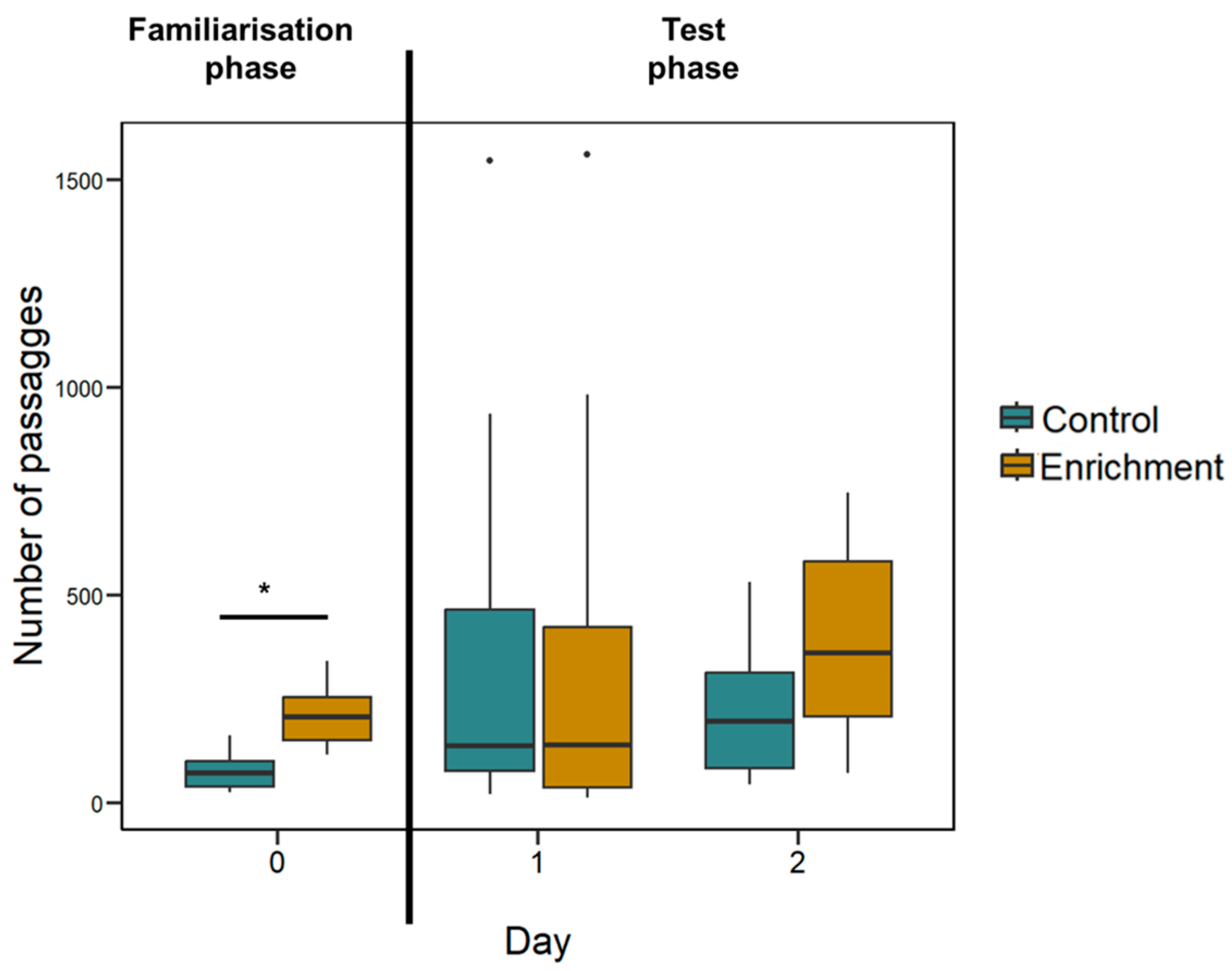
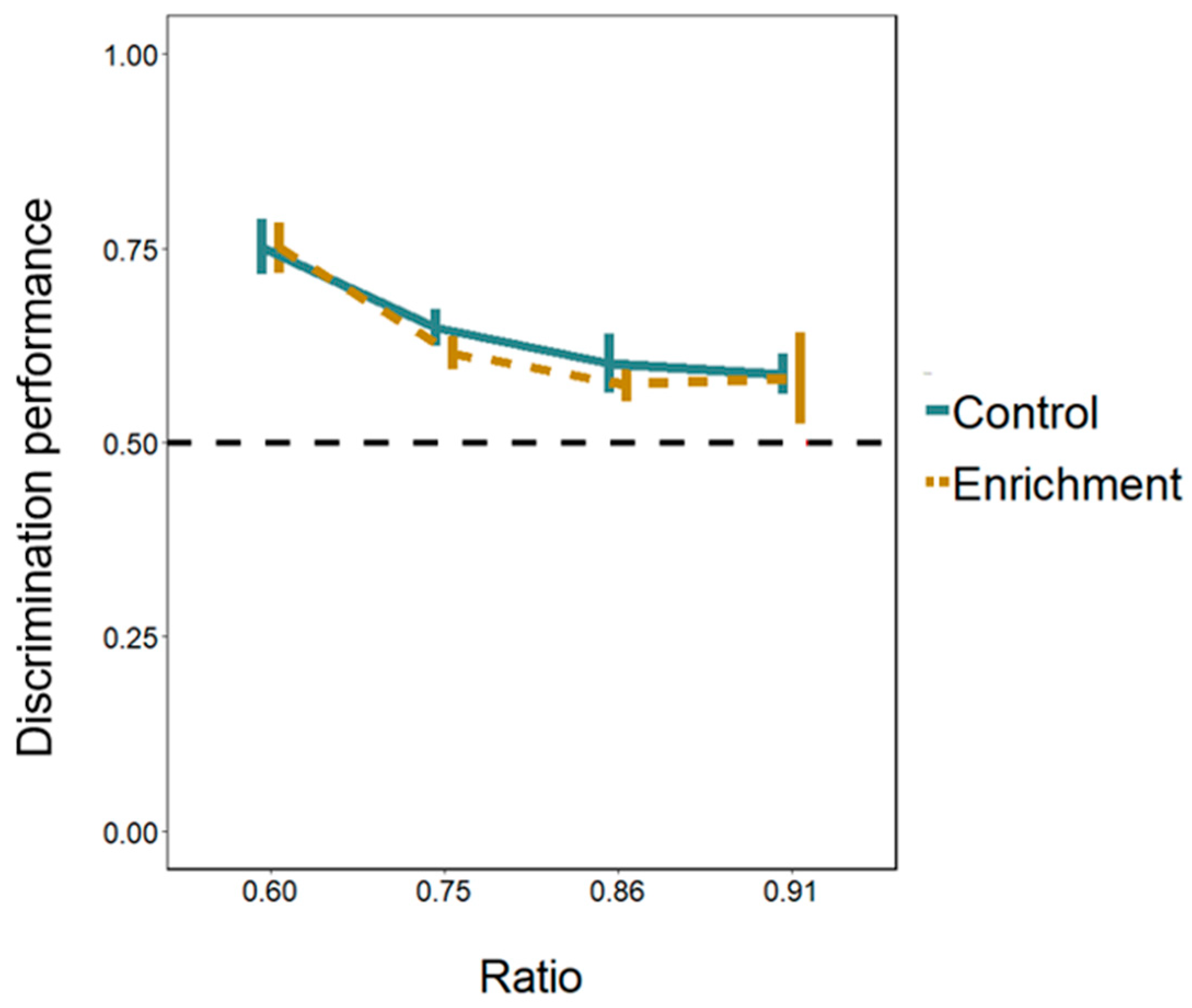
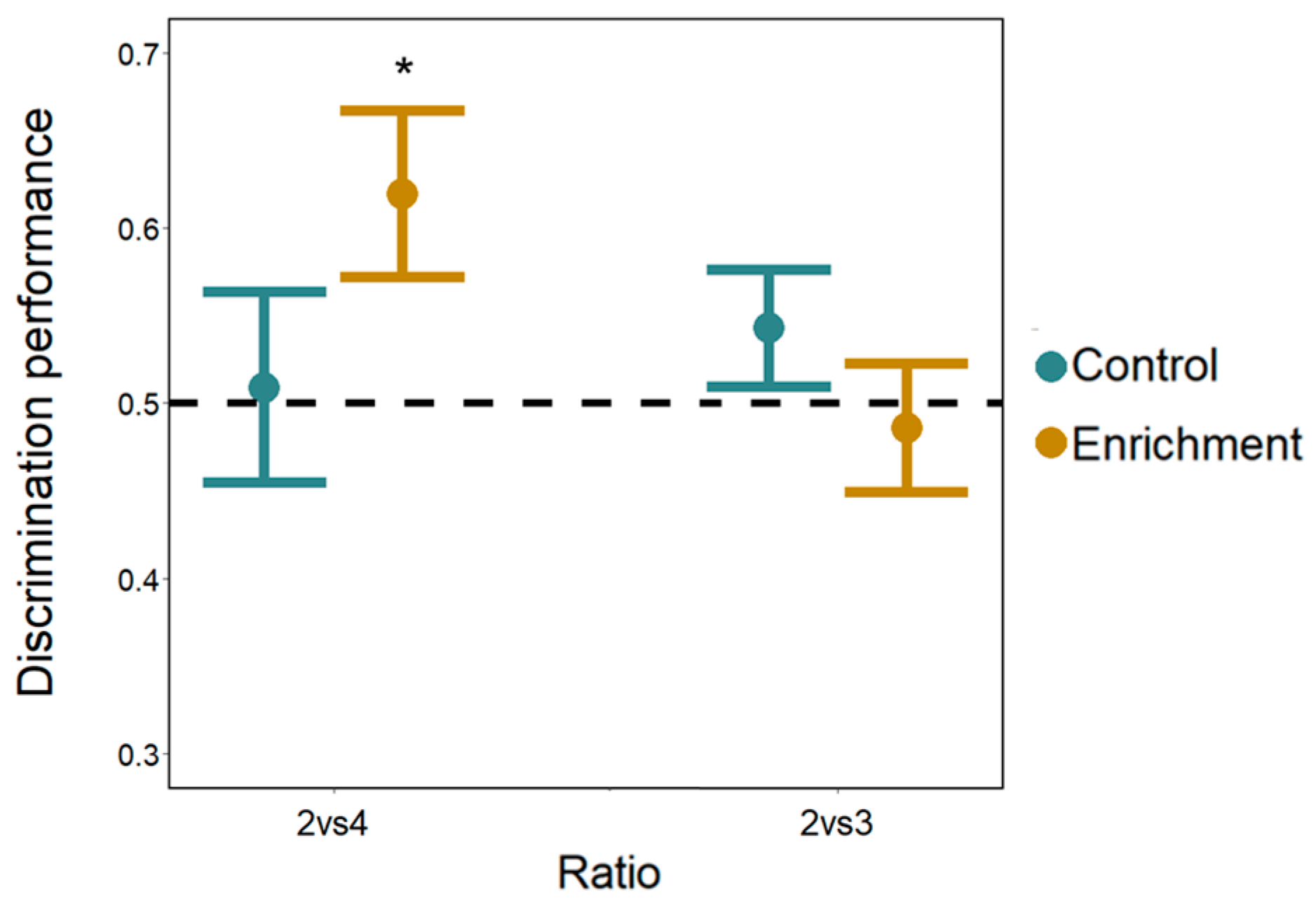
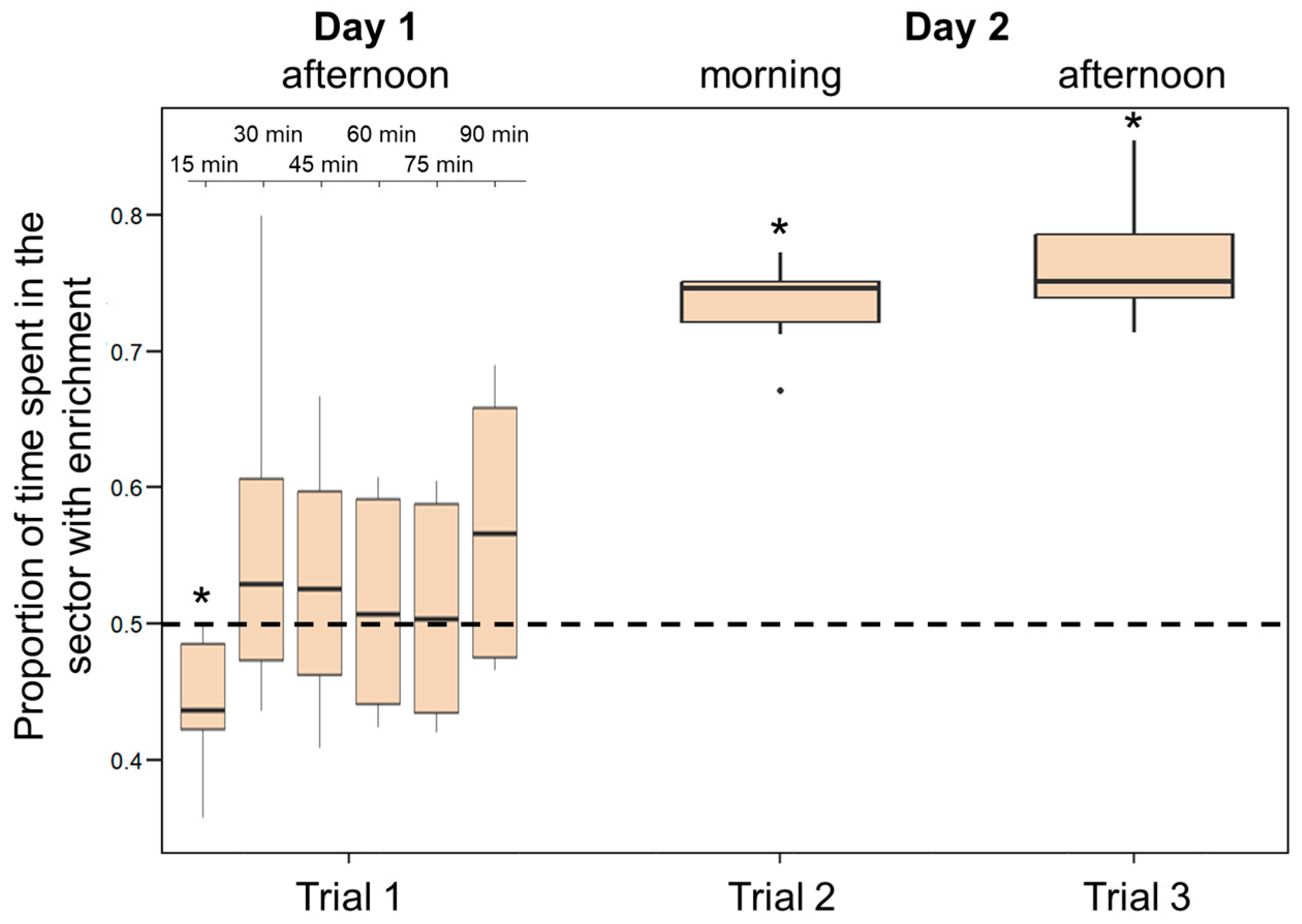
Disclaimer/Publisher’s Note: The statements, opinions and data contained in all publications are solely those of the individual author(s) and contributor(s) and not of MDPI and/or the editor(s). MDPI and/or the editor(s) disclaim responsibility for any injury to people or property resulting from any ideas, methods, instructions or products referred to in the content. |
© 2024 by the authors. Licensee MDPI, Basel, Switzerland. This article is an open access article distributed under the terms and conditions of the Creative Commons Attribution (CC BY) license (https://creativecommons.org/licenses/by/4.0/).
Share and Cite
Santacà, M.; Gatto, E.; Dadda, M.; Bruzzone, M.; Dal Maschio, M.; Bisazza, A. Exploring the Importance of Environmental Complexity for Newly Hatched Zebrafish. Animals 2024, 14, 1031. https://doi.org/10.3390/ani14071031
Santacà M, Gatto E, Dadda M, Bruzzone M, Dal Maschio M, Bisazza A. Exploring the Importance of Environmental Complexity for Newly Hatched Zebrafish. Animals. 2024; 14(7):1031. https://doi.org/10.3390/ani14071031
Chicago/Turabian StyleSantacà, Maria, Elia Gatto, Marco Dadda, Matteo Bruzzone, Marco Dal Maschio, and Angelo Bisazza. 2024. "Exploring the Importance of Environmental Complexity for Newly Hatched Zebrafish" Animals 14, no. 7: 1031. https://doi.org/10.3390/ani14071031




